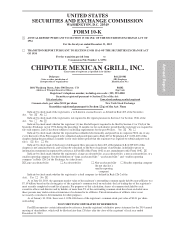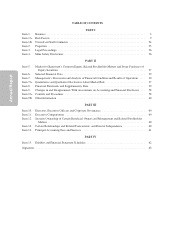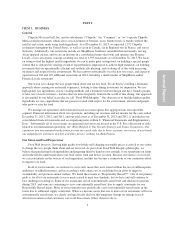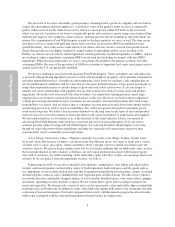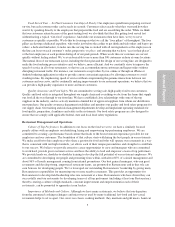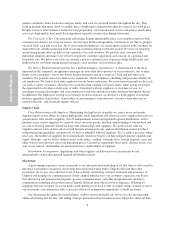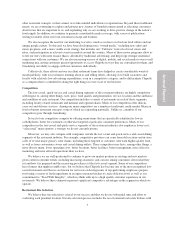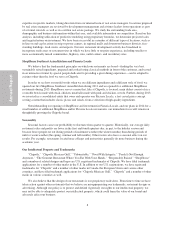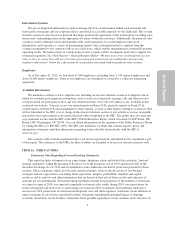Chipotle 2013 Annual Report Download - page 12
Download and view the complete annual report
Please find page 12 of the 2013 Chipotle annual report below. You can navigate through the pages in the report by either clicking on the pages listed below, or by using the keyword search tool below to find specific information within the annual report.
marketing and promotional spending and general and administrative expenses as a percentage of revenue in
2014, and our projections of our effective tax rate for 2014, and other statements of our expectations and plans.
We have used words such as “may,” “will,” “should,” “expect,” “intend,” “plan,” “anticipate,” “believe,”
“think,” “estimate,” “seek,” “expect,” “predict,” “could,” “project,” “potential” and other similar terms and
phrases, including references to assumptions, in this report to identify forward-looking statements. These
forward-looking statements are made based on expectations and beliefs concerning future events affecting us and
are subject to uncertainties, risks and factors relating to our operations and business environments, all of which
are difficult to predict and many of which are beyond our control, that could cause our actual results to differ
materially from those matters expressed or implied by these forward-looking statements. Such risks and other
factors include those listed in this Item 1A. “Risk Factors,” and elsewhere in this report.
When considering forward-looking statements in this report or that we make in other reports or statements,
you should keep in mind the cautionary statements in this report and future reports we file with the SEC. New
risks and uncertainties arise from time to time, and we cannot predict when they may arise or how they may
affect us. We assume no obligation to update any forward-looking statements after the date of this report as a
result of new information, future events or other developments, except as required by applicable laws and
regulations.
Risks Related to our Growth Strategy and Future Expansion
Our sales and profit growth could be adversely affected if comparable restaurant sales increases are less
than we expect, and we may not successfully increase comparable restaurant sales or they may decrease.
While future sales growth will depend substantially on our opening new restaurants, changes in comparable
restaurant sales (which represent the change in period-over-period sales for restaurants beginning in their 13th
full month of operations) will also affect our sales growth and will continue to be a critical factor affecting profit
growth. This is because the profit margin on comparable restaurant sales is generally higher, as comparable
restaurant sales increases enable fixed costs to be spread over a higher sales base. Conversely, declines in
comparable restaurant sales can have a significant adverse effect on profitability due to the loss of the positive
impact on profit margins associated with comparable restaurant sales increases. We expect comparable restaurant
sales increases in 2014 to be in the low to mid-single digits, excluding any menu price increases, due in part to
difficult comparisons with 2013.
Our ability to increase comparable restaurant sales depends on many factors, including:
• changes in consumer preferences and discretionary spending, including weaker consumer spending
during periods of economic difficulty or uncertainty;
• consumer understanding and acceptance of the Chipotle experience and perceptions of the Chipotle
brand;
• our ability to increase menu prices without adversely impacting transaction counts to such a degree that
the impact from lower transactions equals or exceeds the benefit of the menu price increase;
• any “trade down” by customers or other reduction in average check in response to price increases,
which could reduce or eliminate the benefit of the price increase on comparable restaurant sales;
• competition, either from our competitors in the restaurant industry, or from our own restaurants in the
event customers who frequent one of our restaurants begin to visit one of our new restaurants instead;
• executing our strategies effectively, including our development strategy, our marketing and branding
strategies, our initiatives to increase the speed at which our crew serves each customer, expanded use
of fax service lines and online and other electronic ordering, and introductions of catering options and
new menu items, each of which we may not be able to accomplish or which may not have the impact
we expect;
• initial sales performance of new restaurants, which is subject to the risks described below under “Our
new restaurants, once opened, may not be profitable, and may adversely impact the sales of our
existing restaurants”;
10
Annual Report



